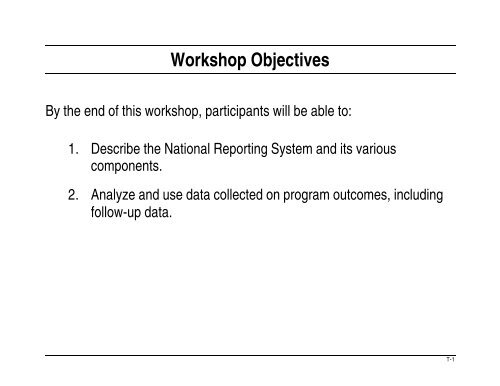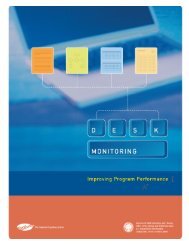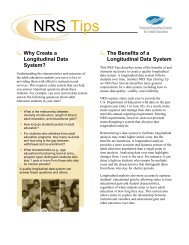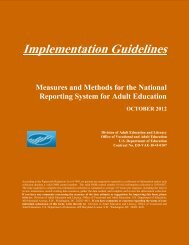Workshop Objectives - National Reporting System
Workshop Objectives - National Reporting System
Workshop Objectives - National Reporting System
You also want an ePaper? Increase the reach of your titles
YUMPU automatically turns print PDFs into web optimized ePapers that Google loves.
<strong>Workshop</strong> <strong>Objectives</strong><br />
By the end of this workshop, participants will be able to:<br />
1. Describe the <strong>National</strong> <strong>Reporting</strong> <strong>System</strong> and its various<br />
components.<br />
2. Analyze and use data collected on program outcomes, including<br />
follow-up data.<br />
T-1
<strong>Workshop</strong> <strong>Objectives</strong><br />
By the end of this workshop, participants will be able to:<br />
1. Describe the <strong>National</strong> <strong>Reporting</strong> <strong>System</strong> and its various<br />
components.<br />
2. Analyze and use data collected on program outcomes, including<br />
follow-up data.<br />
3. Develop a plan for rolling-out professional development on the<br />
<strong>National</strong> <strong>Reporting</strong> <strong>System</strong> in their states.<br />
T-1a
Agenda<br />
Day 1<br />
I. Introduction, <strong>Objectives</strong>, Agenda Review<br />
II.<br />
III.<br />
Cooperative Learning (“Jigsaw”) Overview of the <strong>National</strong> <strong>Reporting</strong> <strong>System</strong><br />
• Read Charts<br />
• Plan Strategies for Sharing Information<br />
• Use Educational Functioning Levels<br />
Group Activity: Data Interpretation and Uses<br />
• Data Scenarios<br />
• Guidelines for Using Data<br />
IV. Wrap Up<br />
Day 2<br />
V. Follow-up Data<br />
• Follow-up Data and Methods for Collection<br />
• Force-Field Analysis: Problem Solving Activity<br />
• Group Activity: Interpreting and Using the Follow-Up Survey Findings<br />
• Role-Play Scenario<br />
VI.<br />
Closing<br />
• Review Parking Lot Issues<br />
• Application of Information<br />
• <strong>Workshop</strong> Evaluation<br />
T-2
Agenda<br />
Day 1<br />
I. Introduction, <strong>Objectives</strong>, Agenda Review<br />
II.<br />
III.<br />
Cooperative Learning (“Jigsaw”) Overview of the <strong>National</strong> <strong>Reporting</strong> <strong>System</strong><br />
• Read Charts<br />
• Plan Strategies for Sharing Information<br />
• Use Educaitonal Functioning Levels<br />
Group Activity: Data Interpretation and Uses<br />
• Data Scenarios<br />
• Guidelines for Using Data<br />
IV. Wrap Up<br />
Day 2<br />
V. Follow-up Data<br />
• Follow-up Data and Methods for Collection<br />
• Force-Field Analysis: Problem Solving Activity<br />
• Group Activity: Interpreting and Using the Follow-Up Survey Findings<br />
• Role-Play Scenario<br />
VI. Principles of Professional Development<br />
VII. Review Parking Lot Issues<br />
VIII. State Planning Activity<br />
• Questions to Consider<br />
• Sharing Strategies<br />
IX. Closing<br />
• Next Steps<br />
• Application of Information<br />
• <strong>Workshop</strong> Evaluation<br />
T-2a
Jigsaw Activity<br />
Expert A<br />
Home Team<br />
Expert B<br />
Home Team<br />
Expert C<br />
T-3
Picking the Winning Horse<br />
Questions<br />
Why Important?<br />
T-4
Choices for Winning Horse<br />
(Tally of Choices)<br />
v Cash Value<br />
v Ruby Lover<br />
v Peter’s Pond<br />
T-5
T-6
T-7
Improve Student Learning Gains<br />
Questions you need answered and why these are important:<br />
Questions<br />
Why Important?<br />
T-8
Guidelines for Data Collection and Use<br />
Guidelines<br />
Example<br />
1. Current situation and needed change(s).<br />
2. Questions to be answered. (in measurable terms)<br />
3. Sources of information.<br />
4. Collect data needed to answer questions.<br />
5. Plan for analysis of data. (Continuous/categories?<br />
Statistical/comparative? Graph/chart/measure?)<br />
6. Interpret the data: (Original Question)<br />
(Patterns/differences?) (Other findings?)<br />
7. Determine use of data: (Instruction? Program?<br />
Community? State/Federal?)<br />
8. New questions? (Need answers?)<br />
T-9
Follow-up Data<br />
• Improve employment and self-sufficiency<br />
• Advance to further education or training<br />
• Obtain a GED or High School Diploma<br />
T-10
Methods of Data Collection<br />
• Local Program Follow-up Surveys<br />
• Data Matching<br />
T-11
Data Matching Using a Shared Interagency Database<br />
Adult Education Program<br />
• Educational Level<br />
• Demographics<br />
• Contact Hours<br />
GED Testing Agency<br />
or Adult Secondary<br />
Institution<br />
• GED Test Results<br />
• Diploma<br />
Wage Records<br />
• Quarterly Wages<br />
Employment Program<br />
• Enrollment<br />
• Type of training<br />
• Service hours<br />
• Demographics<br />
Shared<br />
Interagency<br />
Data base<br />
Social<br />
Security<br />
Number<br />
Combined<br />
Participant Record<br />
or Report<br />
Welfare Program<br />
Post-Secondary Institutions<br />
• Welfare benefits received<br />
• Demographics<br />
• Enrollment<br />
• Demographics<br />
T-12
Force-Field Analysis<br />
Barriers<br />
Solutions<br />
T-13
Follow-up Survey Graphs<br />
D1. Public Assistance Receipt at Intake (n=208)<br />
D2. Public Assistance Maintenance at Follow Up<br />
(n=40)<br />
No Answer<br />
1% (n=2)<br />
Yes<br />
20% (n=42)<br />
No<br />
35% (n=14)<br />
No<br />
79% (n=164)<br />
Yes<br />
65% (n=26)<br />
D3. Employment Status at Intake (n=208)<br />
Not Employed-<br />
Not Looking<br />
20% (n=42)<br />
Employed<br />
53% (n=110)<br />
Not Employed-<br />
Looking<br />
27% (n=56)<br />
T-14a
Follow-up Survey Graphs<br />
D4. Class Helped with Job Maintenance (n=110)<br />
D5. Obtained Job During or Since Class (n=56)<br />
Yes<br />
38% (n=42)<br />
No<br />
32% (n=18)<br />
No<br />
62% (n=68)<br />
Yes<br />
68% (n=38)<br />
D6. Currently Holds Same, Different, or No Job<br />
(n=110)<br />
No Job<br />
16% (n=18)<br />
Different Job<br />
22% (n=24)<br />
Same Job<br />
62% (n=68)<br />
T-14b
Minimizing Survey Errors<br />
• Train interviewers on survey forms<br />
• Understand survey questions, definitions, and phrases.<br />
• Read questions exactly as written and follow instructions<br />
• Complete interview within designated time frame<br />
• Attend to administrative issues as soon as possible<br />
• Know the purpose and structure of the NRS<br />
T-15
Calling Log<br />
Interviewer: ____________________________________________<br />
Date & Time<br />
Name<br />
Contact (who, nature of<br />
conversation, any messages<br />
left, etc.)<br />
Status<br />
(Interview<br />
completed,<br />
scheduled recall)<br />
T-16
Examples of Effective Professional Development<br />
Principle<br />
1. Targets a real need<br />
2. Is spaced over time or continuous<br />
3. Relates to mission and program<br />
goals<br />
4. Provides theory and research<br />
5. Involves effective presenters who<br />
use practical, hands-on, how-toactivities<br />
6. Provides for practice and feedback<br />
7. Results in learning gains or<br />
improved practice<br />
Example<br />
T-17
Examples of Effective Professional Development<br />
T-17









